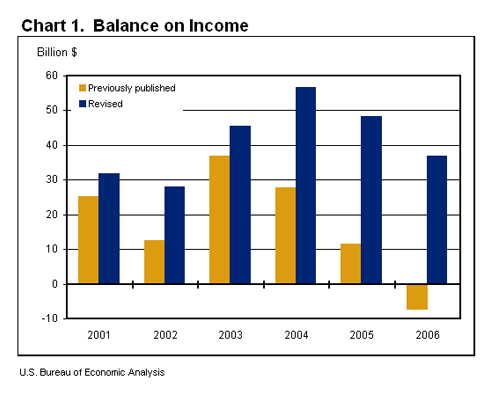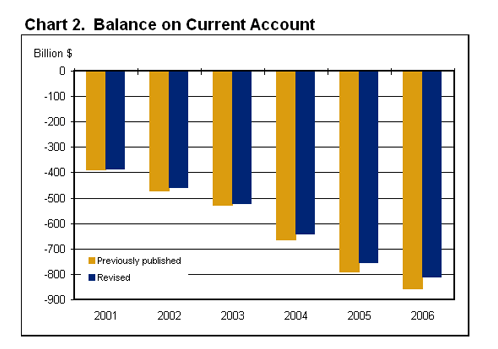As is customary each June, the estimates of U.S. international transactions are revised to incorporate new and updated source data and to introduce methodological changes. Among the more substantive revisions this year were those to the investment income and the services accounts.
Investment income. Direct investment income receipts and payments were revised for 2003-2006. For most years, receipts were revised upward and payments were revised down, resulting in an increase in the surplus on direct investment income. The source of the revision was updated and new responses to BEA’s direct investment surveys.
“Other” private income and U.S. Government income receipts and payments were revised for 2001-2006 to incorporate a methodological change to the estimation of interest received and paid on long-term debt securities. The new methodology uses a more appropriate yield than previously and applies that yield to a more specific, survey-based measure of the type of debt than previously. A current yield is multiplied by an amount of outstanding debt to estimate income paid and received on debt instruments. For most years, the result is to raise income receipts and lower income payments, resulting in a lower deficit on “other” investment income.
Services. Services receipts and payments were revised for 2003-2006, largely to reflect updated and new responses to BEA’s surveys of transactions in private services. Although statistics on services imports (payments) have received close scrutiny in studies and public debate on the offshoring phenomenon, and although BEA has devoted considerable effort to improving its coverage of imports, the revisions were larger for services exports (receipts). Receipts were revised up somewhat and exceeded revisions to payments, which were small. The upward revision in services receipts was concentrated in “other private services”; several of those services categories were revised upward. As a result, the surplus on services is revised up for all years.
BEA follows a number of long-term strategies for improving its estimates of trade in services. These strategies include an external review of statistical procedures for estimating unreported transactions, research into the potential for information on credit card transactions to be used to improve the estimates of travel transactions, and expansion of survey mailing lists. In addition, BEA has worked with the Census Bureau to include a screening question on its 2006 Company Organization Survey to identify companies that import services, so that firms that do not already report to BEA can be included in subsequent BEA surveys on international trade in services.
Charts 1 and 2 summarize the impact of changes to the balance on income and the balance on current account, respectively. Data on the size of revisions for 2006 is shown in the news release, U.S. International Transactions, First Quarter, 2007. Updated estimates for all years are contained in the interactive data base of the international accounts.
Additional information will be published in an article on annual revisions to the international transactions accounts, which will appear in the July Survey of Current Business and will be posted on BEA’s web site.

